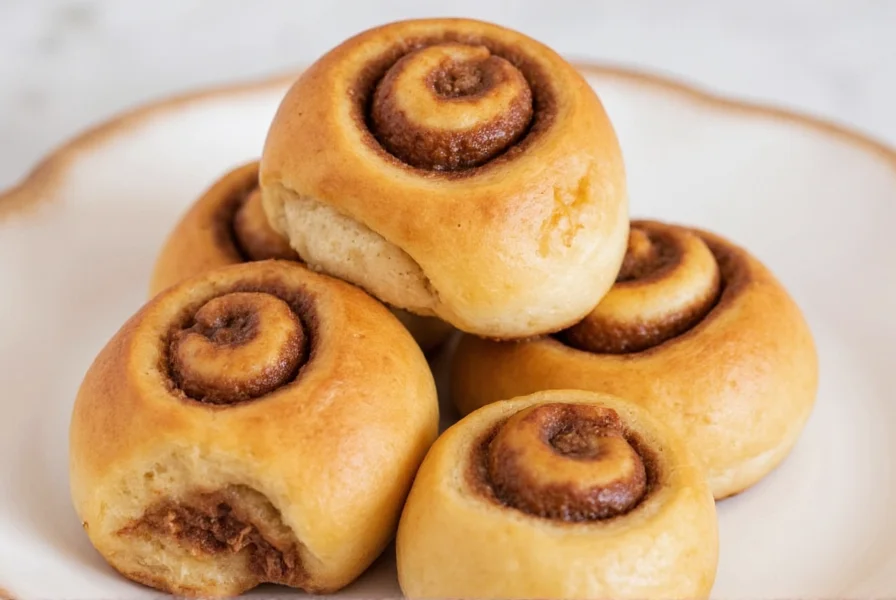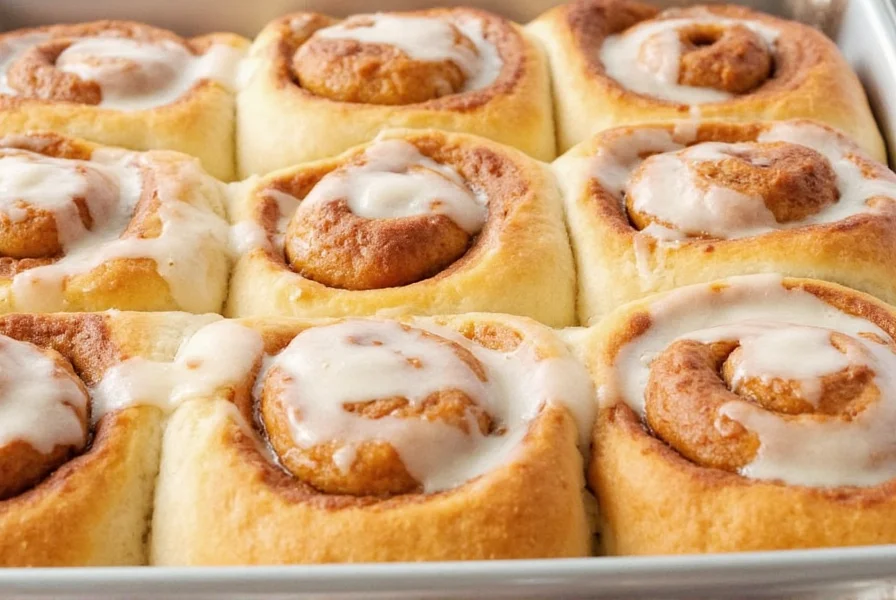The perfect homemade cinnamon rolls recipe features a soft yeast dough with 3 cups all-purpose flour, 1/4 cup warm milk, 2 1/4 tsp active dry yeast, and 1/3 cup melted butter. The filling combines 1/2 cup softened butter, 1 cup packed brown sugar, and 3 tbsp ground cinnamon. After 2 hours of rising and baking at 350°F for 25 minutes, top with cream cheese icing made from 4 oz cream cheese, 1/4 cup butter, 1 cup powdered sugar, and 1/2 tsp vanilla extract.
There's nothing quite like the aroma of freshly baked cinnamon rolls filling your kitchen on a weekend morning. This tested recipe delivers consistently soft, fluffy rolls with just the right balance of sweet dough and spicy cinnamon filling. After perfecting this technique through dozens of test batches over the years, I've identified the precise ratios and timing that transform basic ingredients into bakery-quality results.
Why This Cinnamon Roll Recipe Works
Unlike many online recipes that promise perfection but deliver dense or overly sweet rolls, this version incorporates professional baking principles. The dough hydration level (ratio of liquid to flour) is calibrated for optimal texture - enough moisture for softness without becoming difficult to handle. The yeast activation process ensures consistent rise, while the filling uses melted butter rather than solid for even distribution. These subtle adjustments make the difference between good and exceptional homemade cinnamon rolls.
Ingredients for Perfect Cinnamon Rolls
| Component | Ingredients | Measurements |
|---|---|---|
| Dough | All-purpose flour | 3 cups + extra for dusting |
| Warm milk (110°F) | 1/4 cup | |
| Warm water (110°F) | 1/2 cup | |
| Active dry yeast | 2 1/4 teaspoons | |
| Granulated sugar | 1/4 cup | |
| Filling | Unsalted butter, softened | 1/2 cup (1 stick) |
| Packed brown sugar | 1 cup | |
| Ground cinnamon | 3 tablespoons | |
| Salt | 1/4 teaspoon | |
| Cream Cheese Icing | Cream cheese, softened | 4 ounces |
| Unsalted butter, softened | 1/4 cup | |
| Powdered sugar | 1 cup | |
| Vanilla extract | 1/2 teaspoon | |
| Heavy cream or milk | 1-2 tablespoons |
Step-by-Step Instructions
Preparing the Dough
Dissolve yeast and 1 teaspoon sugar in warm water. Let sit for 5-7 minutes until foamy. In a separate bowl, combine warm milk, melted butter, remaining sugar, salt, and egg. Add yeast mixture to milk mixture. Gradually incorporate flour until a soft dough forms. Knead for 5-7 minutes until smooth and elastic. Place in greased bowl, cover, and let rise for 1-1.5 hours until doubled.
Creating the Filling and Rolling
After the dough rises, punch it down and roll into a 16x12 inch rectangle on a floured surface. Spread softened butter evenly over dough, leaving 1/2 inch border. Mix brown sugar, cinnamon, and salt, then sprinkle evenly over buttered dough. Starting from the long side, roll tightly into a log. Cut into 12 equal pieces using dental floss for clean slices.

Baking to Perfection
Place rolls in a greased 9x13 inch baking dish, cover, and let rise 45-60 minutes until nearly doubled. Preheat oven to 350°F. Bake for 22-27 minutes until golden brown. The internal temperature should reach 190°F when tested with an instant-read thermometer. Remove from oven and prepare icing while rolls cool slightly.
Professional Baking Tips
- Maintain precise liquid temperatures - too hot kills yeast, too cold slows activation
- Use a kitchen scale for flour measurements for consistent results
- Don't skip the second rise - this develops flavor and texture
- Rotate the pan halfway through baking for even browning
- Let rolls cool 10 minutes before icing to prevent melting
Common Mistakes to Avoid When Making Homemade Cinnamon Rolls
Many home bakers encounter issues with their cinnamon rolls due to preventable errors. Using expired yeast is the most common problem - always check your yeast's expiration date and test it in warm water first. Over-flouring the dough creates tough rolls; add flour gradually until the dough just clears the sides of the bowl. Rushing the rising process results in dense texture - proper fermentation takes time. Spacing rolls too closely causes them to bake unevenly. Finally, many recipes use too much cinnamon which creates a bitter flavor - 3 tablespoons provides perfect spice without overwhelming the sweet dough.
Variations and Customizations
This classic homemade cinnamon rolls recipe serves as an excellent base for creative variations. For a caramel twist, replace half the brown sugar with dark corn syrup in the filling. Add chopped pecans or walnuts for texture contrast. Incorporate orange zest into the dough for a citrus note that complements the cinnamon. For a healthier option, substitute half the all-purpose flour with whole wheat flour and reduce sugar by 25%. The cream cheese icing can transform into a simple glaze by using powdered sugar and milk if you prefer less richness. These easy homemade cinnamon rolls also freeze beautifully - bake, cool completely, then wrap individually for up to 3 months.

Serving and Storage Recommendations
Serve homemade cinnamon rolls warm for the best texture and aroma. They pair perfectly with strong coffee or orange juice. Leftovers keep well at room temperature for 2 days in an airtight container. For longer storage, refrigerate for up to 5 days or freeze for 3 months. To refresh, microwave individual rolls for 15-20 seconds or warm in a 300°F oven for 8-10 minutes. Never store cinnamon rolls in the refrigerator without proper wrapping as they'll absorb odors and dry out quickly.
How do you make cinnamon rolls rise faster?
Create a warm environment by placing dough in a turned-off oven with a bowl of hot water. The steam and warmth accelerate yeast activity without overheating. Never use direct heat as temperatures above 110°F kill yeast. This method typically reduces rising time by 25-30% while maintaining proper fermentation.
Why are my homemade cinnamon rolls tough?
Tough cinnamon rolls usually result from over-flouring the dough or over-kneading. Measure flour by spooning into measuring cups and leveling off - never scoop directly. Knead only until the dough becomes smooth and passes the windowpane test. Using bread flour instead of all-purpose can also create excessive gluten development leading to chewy texture.
Can I prepare cinnamon rolls the night before?
Yes, assemble the rolls in the baking dish, cover tightly, and refrigerate overnight. The cold temperature slows but doesn't stop fermentation. In the morning, remove from refrigerator 30 minutes before baking to take the chill off, then allow 30-45 minutes for the final rise at room temperature before baking. This method develops deeper flavor while saving morning preparation time.
What's the ideal baking temperature for cinnamon rolls?
350°F (175°C) provides the perfect balance for homemade cinnamon rolls. Higher temperatures cause uneven baking with burnt exteriors and raw centers. Lower temperatures extend baking time unnecessarily and can dry out the rolls. Use an oven thermometer to verify accuracy as many ovens have calibration issues. Bake for 22-27 minutes until golden brown and internal temperature reaches 190°F.
How can I prevent cinnamon filling from leaking out?
To minimize filling leakage, leave a 1/2 inch border around the dough edges when spreading butter. Roll tightly but gently without compressing the dough. When cutting, use unflavored dental floss pulled through in one motion rather than a knife. Place rolls with the cut side down in the baking dish. Chilling the cut rolls for 10 minutes before the final rise helps the filling set slightly.
Frequently Asked Questions
How do you make cinnamon rolls rise faster?
Create a warm environment by placing dough in a turned-off oven with a bowl of hot water. The steam and warmth accelerate yeast activity without overheating. Never use direct heat as temperatures above 110°F kill yeast. This method typically reduces rising time by 25-30% while maintaining proper fermentation.
Why are my homemade cinnamon rolls tough?
Tough cinnamon rolls usually result from over-flouring the dough or over-kneading. Measure flour by spooning into measuring cups and leveling off - never scoop directly. Knead only until the dough becomes smooth and passes the windowpane test. Using bread flour instead of all-purpose can also create excessive gluten development leading to chewy texture.
Can I prepare cinnamon rolls the night before?
Yes, assemble the rolls in the baking dish, cover tightly, and refrigerate overnight. The cold temperature slows but doesn't stop fermentation. In the morning, remove from refrigerator 30 minutes before baking to take the chill off, then allow 30-45 minutes for the final rise at room temperature before baking. This method develops deeper flavor while saving morning preparation time.
What's the ideal baking temperature for cinnamon rolls?
350°F (175°C) provides the perfect balance for homemade cinnamon rolls. Higher temperatures cause uneven baking with burnt exteriors and raw centers. Lower temperatures extend baking time unnecessarily and can dry out the rolls. Use an oven thermometer to verify accuracy as many ovens have calibration issues. Bake for 22-27 minutes until golden brown and internal temperature reaches 190°F.
How can I prevent cinnamon filling from leaking out?
To minimize filling leakage, leave a 1/2 inch border around the dough edges when spreading butter. Roll tightly but gently without compressing the dough. When cutting, use unflavored dental floss pulled through in one motion rather than a knife. Place rolls with the cut side down in the baking dish. Chilling the cut rolls for 10 minutes before the final rise helps the filling set slightly.











 浙公网安备
33010002000092号
浙公网安备
33010002000092号 浙B2-20120091-4
浙B2-20120091-4